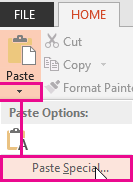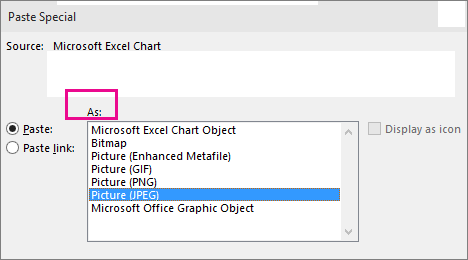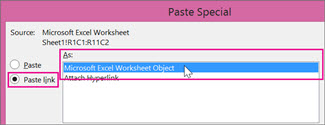You can specify formatting when you paste slides, text, pictures, objects, and tables from other programs or the web into your Microsoft 365 app.
Using Paste Special
Text has its own formatting — such as typeface, color, and font size. When you copy text into a Microsoft 365 app, the app automatically reformats that text to match the text of the destination. However, you can use Paste Special to maintain the original formatting or to paste it as a picture or a link.
-
Cut or copy the slide, picture, text, or object that you want to paste.
-
Click in your Microsoft 365 file at the place where you want to insert that item.
-
On the Home tab, in the Clipboard group, select the arrow under Paste, then select Paste Special, and then choose one of the options below.
(If you're using Outlook, start on the Message tab, rather than the Home tab.)

Tip: If you'd prefer to use the keyboard, in step 3, you can press Ctrl+Alt+V to invoke Paste Special.
-
In the Paste Special dialog, on the left, select either Paste or Paste link, as described below.
-
Paste allows you to insert formatted text, unformatted text, or an image.
-
Paste link allows you to insert a hyperlink that connects to a separate document or presentation.
-
Read the two sections below for more details about the Paste and Paste link options:
Paste
Following are the possible formatting options you can choose for pasting:
|
Use this format |
When |
|---|---|
|
Formatted Text |
You want the text to retain the formatting of the text from the original app or web page. |
|
Unformatted Text |
You want the text to take on the formatting of the Microsoft 365 app you're pasting to. |
|
Microsoft Office Drawing Object |
You want the object you're pasting to appear as a Microsoft Office drawing object. |
|
Picture (GIF) |
You want the object you're pasting to appear as a Graphics Interchange Format (GIF) picture. The GIF file format is limited to 256 colors, and is therefore most effective for scanned images, such as illustrations, and less effective for color photographs. GIF is also a good file format for line drawings, black and white images, small text that is only a few pixels high, and animation. |
|
Picture (JPEG) |
You want the object you're pasting to appear as a Joint Photographic Experts Group (JPEG) picture.  The JPEG file format supports 16 million colors and is best suited for photographs and complex graphics. |
|
Picture (PNG) |
You want the object you're pasting to appear as a Portable Network Graphics (PNG) picture. The PNG file format is similar to GIF but it provides better color support. It compresses solid areas of color while preserving sharp detail, such as the detail in line art, logos, or illustrations with text. You can save, restore, and re-save a PNG image without degrading its quality. Unlike GIF files, PNG does not support animation, and some older web browsers and applications do not support PNG. |
|
Picture (Windows Metafile) |
You want the object you're pasting to appear as a Windows Metafile Format (WMF) picture. You can save a picture as a 16-bit graphic (for use with Windows 3.x and later). |
|
Picture (Enhanced Metafile) |
You want the object you're pasting to appear as an Enhanced Metafile (EMF) format. You can save a picture as a 32-bit graphic, which supports more sophisticated graphics functions. |
|
Device Independent Bitmap |
You want the object you're pasting to appear as a Device Independent Bitmap (DIB), such as a slide acting as a graphic for use on web pages. A DIB is a representation (that consists of rows and columns of dots) of a graphics image in computer memory. The value of each dot (filled in or not) is stored in one or more bits of data. |
|
Bitmap |
You want the object you're pasting to appear as a bitmap. The Microsoft Windows BMP format can display millions of colors. Because it is supported by several programs, it is an extremely practical file format to use when you are providing an image to someone who may not have the program in which you created the image. |
Paste link
To add a hyperlink connecting to a separate document or presentation, select Paste Link.

Note: The Paste Link option is unavailable if you cut or copied content from a document that does not support the Paste Link option, or if the document that you are attempting to link to has not been saved.
To paste the content as an Object Linking and Embedding (OLE) application icon (rather than pasting the actual content), select the Display as icon check box. You can click the icon to open the application, and then view the content. The Display as icon check box is only available if you use Paste Link or if you paste the content as an OLE object. You can then change the icon for the content that you pasted.










